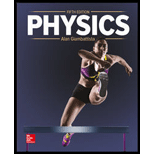
Concept explainers
(a)
The number of
(a)
Answer to Problem 84P
The number of
Explanation of Solution
The percentage of oxygen in dry surface air is
Write the formula for the number of oxygen molecule for cubic meter of air.
Here,
Write the formula for the mass of air.
Here,
Substitute equation (II) in equation (I).
Write the formula for the molar mass of air.
Here,
Substitute equation (IV) in equation (III).
Conclusion:
Substitute
The number of
(b)
The percentage of oxygen molecule in the tank of the diver who goes to a depth of
(b)
Answer to Problem 84P
The percentage of oxygen molecule in the tank of the diver who goes to a depth of
Explanation of Solution
The percentage of oxygen in dry surface air is
Write the ideal gas equation.
Here,
When number of moles and temperature is constant, the volume is inversely proportional to the pressure.
Write the equation for the ratio of initial and final volume.
Here,
Write the equation for the percentage of oxygen molecules in the tank.
The initial pressure is at atmospheric pressure.
Here,
Write the formula for the final pressure.
Here,
Substitute equation (VI) and (VII) in equation (V).
Conclusion:
Substitute
The percentage of oxygen molecule in the tank of the diver who goes to a depth of
Want to see more full solutions like this?
Chapter 13 Solutions
Physics
 College PhysicsPhysicsISBN:9781305952300Author:Raymond A. Serway, Chris VuillePublisher:Cengage Learning
College PhysicsPhysicsISBN:9781305952300Author:Raymond A. Serway, Chris VuillePublisher:Cengage Learning University Physics (14th Edition)PhysicsISBN:9780133969290Author:Hugh D. Young, Roger A. FreedmanPublisher:PEARSON
University Physics (14th Edition)PhysicsISBN:9780133969290Author:Hugh D. Young, Roger A. FreedmanPublisher:PEARSON Introduction To Quantum MechanicsPhysicsISBN:9781107189638Author:Griffiths, David J., Schroeter, Darrell F.Publisher:Cambridge University Press
Introduction To Quantum MechanicsPhysicsISBN:9781107189638Author:Griffiths, David J., Schroeter, Darrell F.Publisher:Cambridge University Press Physics for Scientists and EngineersPhysicsISBN:9781337553278Author:Raymond A. Serway, John W. JewettPublisher:Cengage Learning
Physics for Scientists and EngineersPhysicsISBN:9781337553278Author:Raymond A. Serway, John W. JewettPublisher:Cengage Learning Lecture- Tutorials for Introductory AstronomyPhysicsISBN:9780321820464Author:Edward E. Prather, Tim P. Slater, Jeff P. Adams, Gina BrissendenPublisher:Addison-Wesley
Lecture- Tutorials for Introductory AstronomyPhysicsISBN:9780321820464Author:Edward E. Prather, Tim P. Slater, Jeff P. Adams, Gina BrissendenPublisher:Addison-Wesley College Physics: A Strategic Approach (4th Editio...PhysicsISBN:9780134609034Author:Randall D. Knight (Professor Emeritus), Brian Jones, Stuart FieldPublisher:PEARSON
College Physics: A Strategic Approach (4th Editio...PhysicsISBN:9780134609034Author:Randall D. Knight (Professor Emeritus), Brian Jones, Stuart FieldPublisher:PEARSON





